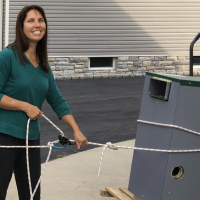Best Of
Re: Residential boiler cycling again. House cold.
If the gauge is right, the expansion tank needs to be drained.
With that amount of water, it should've been piped P/S. I would try closing the bypass. What speed is the circulator on? Not sure if that's correct either.
 HVACNUT
HVACNUT
Re: Residential boiler cycling again. House cold.
Can you get a photo from farther back? Trying to put the pieces together like a puzzle is difficult. even with the diagrams I can get that you are having 2 problems.
- Not enough heat
- Relief valve releasing water/Pressure in boiler too high
Number 2 may be causing the other problem.
you need to be sure that the expansion tank has enough air in it. Air in the expansion tank is the cushion for when the water expands as it gets hotter. If there is not enough air in the tank to compress, as the water in the system expands, the pressure will get too high and the relief valve will release water on the the floor.
To get air in the expansion tank you can open a boiler drain in the system somewhere (you already have a hose on it) and let water out of the boiler. This will lower the boiler pressure to zero on the gauge. When that happens you can open the drain valve on the expansion tank just a little and you will hear Air gurgle into the tank. Open it just enough to get the air to go in as the water leaves the boiler at the bottom drain valve.
This may take 10 minutes or more. When you hear the sound of the air gurgling into the tank change, that will indicate that the tank is full of air and you can quickly close both valves. You want to pay attention to make sure you do not let too much air into the tank, because the air will start to get into the system pipes and that air will need to be removed later.
Once you have the Tank filled with air and the valves closed, you can open the fill valve and get the boiler pressure up to 12 PSI. You do not need any more than 12 PSI in your home. The tank will then start to fill with water again and compress the full tank of air to 12 PSI. That means the water in the tank will be about ⅔ full and ⅓ of compressed air at 12 PSI. That is where you want to start the boiler with cold water. Now you can turn on the burner and heat the water in the system. If the radiators only get hot across the bottom, then there is air in them and you will need to vent the radiators while adding water to keep the boiler pressure to 12 PSI. Once the system is operating with an expansion tank properly filled with air, the pressure should not get above 20 PSI and you will have a working heating system. If the house does not get warm enough with 160° water, then you can increase the boiler limit control to let the water get to 180°. If that is still not enough, then you can set the limit to 195°. But I doubt that you will need to do that.
Re: Heating recommendation for Jackson, WY
Hello,
I see you got some advice from Hot Rod! He is an expert when it comes to hydronic heating. I had the pleasure of attending a training with him years ago in MT. I now live and work in Jackson doing all types of mechanical, electrical, and plumbing installs. We specialize in design and installation of conventional and geothermal based heating systems. Your welcome to email me directly to talk about options for your project. I am also happy to have you come to my office if you would like to go over plans and options. vlovejoy@energy-1.net
Re: Before you swap a component
Service techs in most cases will not clean contacts. You pay for a service call. If they clean contacts and get a call back who pays for the second call?
If you're working on your own equipment that is fine, but contractors will usually not want to do that and will replace the control if it is a simple swap.
Probably the most important issue is to make sure the controls are selected properly so the relays etc have ample capacity for the load they control.
Re: Near boiler piping
As often as possible would be every hour on the hour so no, I think that would be too often. You have to kind of judge it based on if there's any gunk coming out.
Like if it were mine I would skim it and see if any gunk came out. If some gunk/sheen came out with the water I would skim it again in a couple days.
You have to carefully watch during the beginning part of the skim to see if anything is coming out. A tee with the bullhead part facing upwards makes a good display port to view the stuff floating out.
Re: White plume of smoke
If your boiler is Catholic, you may have just elected a new Pope
Re: Upgrading my Thermostat to wifi without C wire / Using switch relay with internal transformer
Try using terminals A & B. They switch at the same time as X1 & X2.
You can check X1 & X2 by removing the wires & checking for continuity/resistance. Should be continuity/low resistance (≈<1Ω) with a heat call and no continuity/open circuit (OL etc.) with no heat call.
Re: Heat Pump vs. Furnace energy usage 2024-2025 results
@ethicalpaul don’t have to convince me! Just waiting for the right time.
Re: Steam Mains Insulate or not?
Thanks Intplm. It is fiberglass. That I am sure of, because I put it in myself.
Re: Heat Pump vs. Furnace energy usage 2024-2025 results
With @jesmed1's anaylsis It appears you did revealed a rough ratio of gas versus KWh. If a therm of natural gas is less than 10x a KWh, then a heat pump is economical to operate.
But, that's some expensive natural gas! In Western NY, I'm at $0.85/therm. I pay around $0.18/kwh for electric. So for me, natural gas is a lot cheaper.
 KarlW
KarlW


